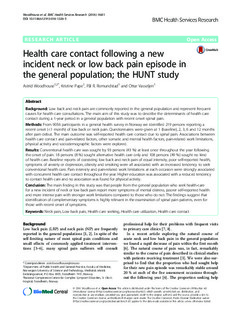| dc.contributor.author | Woodhouse, Astrid | |
| dc.contributor.author | Pape, Kristine | |
| dc.contributor.author | Romundstad, Pål Richard | |
| dc.contributor.author | Vasseljen, Ottar | |
| dc.date.accessioned | 2016-03-08T09:45:11Z | |
| dc.date.accessioned | 2016-04-26T11:27:14Z | |
| dc.date.available | 2016-03-08T09:45:11Z | |
| dc.date.available | 2016-04-26T11:27:14Z | |
| dc.date.issued | 2016 | |
| dc.identifier.citation | BMC Health Services Research 2016, 16(81) | nb_NO |
| dc.identifier.issn | 1472-6963 | |
| dc.identifier.uri | http://hdl.handle.net/11250/2387389 | |
| dc.description.abstract | Low back and neck pain are commonly reported in the general population and represent frequent
causes for health care consultations. The main aim of this study was to describe the determinants of health care
contact during a 1-year period in a general population with recent onset spinal pain.
Methods: From 9056 participants in a general health survey in Norway we identified 219 persons reporting a
recent onset (<1 month) of low back or neck pain. Questionnaires were given at 1 (baseline), 2, 3, 6 and 12 months
after pain debut. The main outcome was self-reported health care contact due to spinal pain. Associations between
health care contact and pain-related factors, other somatic and mental health factors, pain-related work limitations,
physical activity and sociodemographic factors were explored.
Results: Conventional health care was sought by 93 persons (43 %) at least once throughout the year following
the onset of pain. 18 persons (8 %) sought alternative health care only and 108 persons (49 %) sought no kind
of health care. Baseline reports of coexisting low back and neck pain of equal intensity, poor self-reported health,
symptoms of anxiety or depression, obesity and smoking were all associated with an increased tendency to seek
conventional health care. Pain intensity and pain-related work limitations at each occasion were strongly associated
with concurrent health care contact throughout the year. Higher education was associated with a reduced tendency
to contact health care and no association was found for physical activity.
Conclusion: The main finding in this study was that people from the general population who seek health-care
for a new incident of neck or low back pain report more symptoms of mental distress, poorer self-reported health
and more intense pain with stronger work limitations compared to those who do not. The findings suggest that
identification of complementary symptoms is highly relevant in the examination of spinal pain patients, even for
those with recent onset of symptoms. | nb_NO |
| dc.language.iso | eng | nb_NO |
| dc.publisher | BioMed Central | nb_NO |
| dc.rights | Navngivelse 3.0 Norge | * |
| dc.rights.uri | http://creativecommons.org/licenses/by/3.0/no/ | * |
| dc.title | Health care contact following a new incident neck or low back pain episode in the general population; the HUNT study | nb_NO |
| dc.type | Journal article | nb_NO |
| dc.type | Peer reviewed | nb_NO |
| dc.date.updated | 2016-03-08T09:45:11Z | |
| dc.source.volume | 16 | nb_NO |
| dc.source.journal | BMC Health Services Research | nb_NO |
| dc.source.issue | 81 | nb_NO |
| dc.identifier.doi | 10.1186/s12913-016-1326-5 | |
| dc.identifier.cristin | 1342894 | |
| dc.description.localcode | This article is distributed under the terms of the Creative Commons Attribution 4.0 International License (http://creativecommons.org/licenses/by/4.0/), which permits unrestricted use, distribution, and reproduction in any medium, provided you give appropriate credit to the original author(s) and the source, provide a link to the Creative Commons license, and indicate if changes were made. The Creative Commons Public Domain Dedication waiver (http://creativecommons.org/publicdomain/zero/1.0/) applies to the data made available in this article, unless otherwise stated. | nb_NO |

